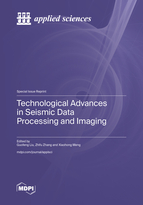Sparse Parabolic Radon Transform with Nonconvex Mixed Regularization for Multiple Attenuation
Round 1
Reviewer 1 Report
Dear authors,
Your research paper, mainly proposes a sparse parabolic Radon transform for seismic data processing and interpretation in seismic reflection exploration with the non-convex ??1 − ??2 0 < ?1, ?2 < 1) mixed regularization (SPRT??1 − ??2), which aims to constrain the sparsity of primary or multiple reflections to overcome energy diffusion and improve the effect of multiple attenuation. The manuscript clearly demonstrates the efficiency of the proposed approach in multiple attenuations for both synthetic and field data by comparing it with widely used other Radon transform approaches, including the least squares parabolic Radon transform (LSPRT) and the sparse parabolic Radon transform based on ?1-regularization (SPRT?1). Therefore, I found your research study valuable to the readers of the Journal of Applied Sciences as the topic is attractive to researchers interested in the community in question, as it clearly addresses a specific gap in the field. Please taking into account the following suggestions in the revision.
1 1. The similarity index of the study (24%) needs to be lowered in the revision.
2. It would be nice if you could mention the nonlinearity of the inverse problem under consideration. Also, I think you should use more familiar methodological terms such as Levenberg-Marquardt and Tikhonov regularization in the related equations.
3. Undoubtedly, Fig. 5 is very useful to show the efficiency of your proposed approach in this work. If you have the numerical values for the synthetic and the results obtained with the presented approaches, please provide a difference image map.
Author Response
Please see the attachment.
Author Response File: ![]() Author Response.docx
Author Response.docx
Reviewer 2 Report
The paper proposes a sparse parabolic Radon transform in the frequency domain with the nonconvex ??1−??2(0<?1,?2<1) mixed regularization that constrains the sparsity of primary and multiple reflections. The topic is interesting, and the method presented has enough novelty to be published. English is sufficient. A few comments are as follows:
1) The improvement aspects of the proposed method are well demonstrated via real and synthetic data applications. However, the authors are advised to show that how these improved aspects can affect the final outcome of a real problem? And in what extent, such improvements (in the final outcome of a real application) can be measured and quantified?
2) Equation 26: Is there any reference for this mathematical relation? If so, please cite it.
3) Line 262: The conclusion that the proposed method is suitable for seismic data with missing traces is remarkable especially when the example is developed for a relatively large number of 50% of missing traces. How is the authors’ evaluation on a larger percent of missing traces?
4) Line 273: How much the outcomes of this study depend on the initial parameters assumed by the authors? For instance, when saying that the time of 3.2-4.8 s is chosen, or when the number of offset traces is taken as 92; the question is if these pre-defined values may affect the final results in terms of comparison between the three methods discussed in the manuscript? In other words, what is the basis in selecting the initial parameters in the present study?
5) The authors are advised to cite the following paper in the references:
Soleimani-Babakamali MH, Sepasdar R, Nasrollahzadeh K, Sarlo R. A system reliability approach to real-time unsupervised structural health monitoring without prior information. Mechanical Systems and Signal Processing. 2022 May 15;171:108913.
Author Response
Please see the attachment.
Author Response File: ![]() Author Response.docx
Author Response.docx





